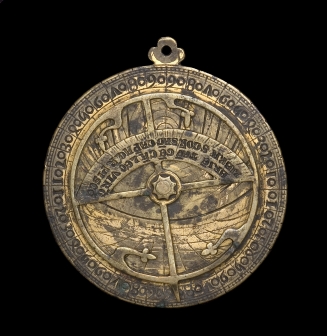| Date | ca. 1300 (?) |
| Place | Sicily |
| Material | Gilt brass |
| Inventory no. | 40829 |
| Acquisition | Presented by Lewis Evans in 1924 |
The smallest astrolabe in the collection is also one of the more ingenious. The rete combines a northern and southern projection of the ecliptic, which is then folded over upon itself so that the twelve zodiacal signs all lie on the same arc below the center of the rete. The rete was then reduced so that the outer edge is the equatorial circle rather than the Tropic of Capricorn, as is more common. One consequence of such a construction is that the astrolabe has lost much of its representational ability. That is, the instrument does not function well as a model of the heavens. Instead, it has become a more abstract instrument.
That this instrument was not intended to be an observational or representational instrument is reinforced by it minute size. Far too small to be a useful observational tool, it also lacks much of the engraving that would have made detailed representation possible. Moreover, the four stars on the rete are not named. On a normal rete, the absence of names would not have caused much concern. On this rete, where the user must determine whether the star indicated is for the northern or southern projection, the lack of names presents some difficulty.
So unconventional an astrolabe is not easy to date, and with so little to set alongside it for comparison only detailed study of context can refine what begins as guesswork. Lewis Evans, whose judgement has always proved sound, proposed a date of about 1460, which has prevailed since. A recent study looking at this instrument as evidence of 'an ingenious tradition of non-standard astrolabes' proposes the much earlier date of about 1300.
View all
images for this astrolabe
View
detailed provenance for this astrolabe
Mater
The mater and limb are of one-piece construction. The limb of the mater is simply that portion of the plate that extends beyond the rete. Scales on the limb: degree scale. More informationBack
The back contains 3 scales of the following types: Degree; Unequal hours; Shadow square. More informationRete, Rivet
The rete contains 4 stars. The zodiac on the rete is labelled: ARIĒ , TAṼ , GĒ , CĀ , LEO , VIRḠ , LIBRA , SCOR , SAḠ , CAP , AQR , PISCE.The rete contains 1 scale of the following type: Ecliptic.
The rete is attached using a rivet. The pin appears to be a rivet with a star-shaped head on the front. More information


